A biting cold north north-westerly and some very heavy showers made birding uncomfortable today, but we were rewarded with some very good birds.
Arriving at the car park at Oare Marshes NR at 7.40 a.m. (before the wind and rain started), we were immediately treated to the sight of a Barn Owl hunting just behind the sea wall and around 1000 Golden Plover were spectacularly wheeling over the floods.
We decided that, as the incoming tide could produce some decent sea birds, we would head straight for the Sea Wall Hide.
On the way we heard a Cetti's Warbler (and later heard and saw another one low in the reeds). A Water Rail was squealing in the ditch near the top of the slipway but remained hidden, two Little Egrets were flying over the reserve, the Barn Owl was seen hunting again and a Bearded Tit was heard 'pinging' in the reeds near the hide.
.JPG)
The dark and gloomy view across the East Flood from the Sea Wall Hide. (Graham)
Arriving at the hide, it was a while before much of note was seen, plenty of Shelducks, Redshanks, Curlews, Dunlin, Oystercatchers and a few Turnstones and Grey Plovers.
As high tide approached, the bitter wind strengthened and 70+ Avocets flew across the Swale towards Sheppey and a female Eider was seen on the water. Also, 2 male and 3 female Red-breasted Mergansers touched down briefly on the Swale. At least 200 Brent Geese were along the Sheppey side of the water and the sudden appearance of a flock of 100 plus Kittiwakes with an adult Little Gull amongst them was a surprise. The Kittiwakes remained over the Swale for most of the morning, often alighting on the water.
Taking a break from seawatching, we headed to the hide on the East Flood. Two Rock Pipits were at the sluice and when we arrived at the hide, 5 Pintail, 40-plus Snipe, a Little Stint, c150 Black-tailed Godwits and huge numbers of Golden Plover were roosting on the East Flood along with plenty of Lapwings and a Grey Plover. We had just made it to the hide when the first really heavy and prolonged shower set in.
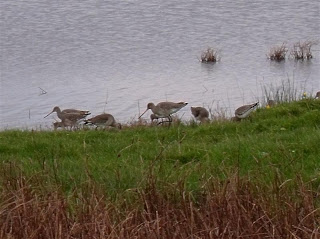.JPG)
Black-tailed Godwits (Graham)
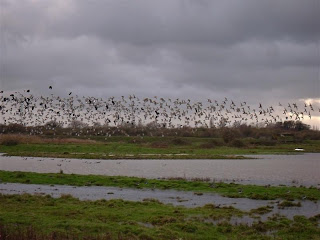.JPG)
Golden Plovers and Lapwings (Graham)
After the shower passed, we headed back to the seawall hide for another seawatch.
It wasn't too long before we spotted a dark bird skimming over the water on the southern side of the Swale - a Sooty Shearwater. It behaved just as it should, shearing over the waves and twisting and turning to show all the correct features to identify it. It crossed the water to the Sheppey side and headed back east towards the mouth of the Swale.
A while later, Paul noticed a group of large dark birds heading west, fairly high over the water. These turned out to be 8 Great Skuas. A Red-throated Diver alighted on the Swale for a short time before heading off distantly to the east.
Murray Wright (he of Tufted Puffin fame) arrived and after chatting for a while, we continued our seawatch whilst Murray took up position outside the hide. It was not long before we saw a skua arrive from the east, low over the water. Neither of us were certain of its ID, not as broad -winged as a Great Skua and showing much contrast of dark and light areas in its plumage. I rushed outside to alert Murray, but he was already on to the bird and readily identified it as an immature Pomarine Skua.
Later in the afternoon, Murray alerted us to a female Hen Harrier hunting over the East Flood. Paul soon picked it up in his bins, but I failed to do so!
Despite the miserable weather conditions, it turned out to be a very worthwhile visit with both of us adding several species to our year lists. Our disappointment of not being able to digiscope successfully in such conditions goes without saying.
Paul & Graham
Paul made a visit to Oare Marshes NR (unfortunately, I wasn't able to join him due to prior committments) and on arrival he watched a Barn Owl fly over the car park. It then spent a few minutes hunting over the East Flood. There were plenty of Golden Plovers in the area which gave him the opportunity to get the superb shot below.
+(1)+(Medium).JPG)
GOLDEN PLOVERS at Oare Marshes NR, North Kent (Paul)
Whilst at Oare, another birder told him about the Snow Buntings at Reculver so he decided to give it a go. It took about a mile's walk along the sea wall before Paul located the Snow Buntings, about 20 birds in all, but they were very flighty and made it difficult to get a photo, but he managed one record shot.
+(1)+(Medium).JPG)
SNOW BUNTING at Reculver, North Kent (Paul)
We decided to pay a visit to Weirwood Reservoir in East Sussex, in the hope that the Grey Phalarope would still be present.
On arrival, we scanned the mud from the car park near the hide but the bird proved hard to spot. Some 15 minutes passed before we eventually noticed it in the distance scurrying around on the mud.
Unfortunately, during our stay, it never approached close enough to get a good photo but it was still a good sighting for us.
+(1)+(Medium).JPG)
GREY PHALAROPE at Weirwood Reservoir, East Sussex (Paul)
.JPG)
+(Medium).JPG)
.JPG)
.JPG)
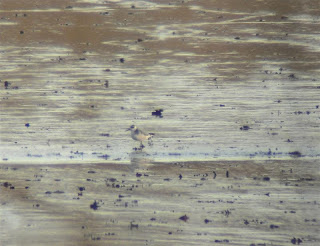.JPG)
.JPG)
GREY PHALAROPE at Weirwood Reservoir, East Sussex (Graham)
Other birds of note seen at Weirwood included a Marsh Tit and a Nuthatch on the feeders and around 6 Siskins and a Lesser Redpoll feeding high on an alder. About twelve Common Snipe flew low over the area in front of the hide and a Green Sandpiper was feeding on the mud. A female Sparrowhawk grabbed a small item of prey from the ground not far from us and flew off with it. Four Roe Deer were out on a dry area of the reservoir in front of the hide.
.JPG)
MARSH TIT at Weirwood Reservoir, East Sussex (Graham)
+(Medium).JPG)
ROE DEER at Weirwood Reservoir, East Sussex (Graham)
We next decided to visit Bough Beech Reservoir in West Kent before heading for RSPB Elmley in North Kent to see if we could add Merlin and Short-eared Owl to our year lists.
Bough Beech Reservoir was as quiet as I have ever seen it, with little of note apart from a few Fieldfares.
So it was on to Elmley. We arrived there at 11.45 a.m. and scanned the area behind the toilet block for raptors. A Marsh Harrier was quartering the ground in the distance and Paul noticed a small raptor perched on a distant gate post out on the marshes, a female Merlin, which flew off low across the marsh in typical dashing flight.
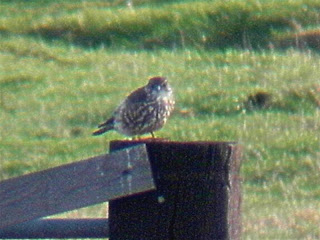+(1)+(Medium).JPG)
Female MERLIN at RSPB Elmley Marshes, North Kent (Paul)
Behind the orchard, at least 20 Curlews were feeding on the short grass. Heading down to the sea wall, Paul spotted something on the ground in the distance and we were soon scoping a superb female Peregrine.
.JPG)
Female PEREGRINE at RSPB Elmley Marshes, North Kent (Graham)
Further along the track there were 2 Stonechats and on arriving at the first hide we spotted another 2 Marsh Harriers and a Common Buzzard and then the female Merlin appeared from nowhere and started to persue a small passerine. The agility of this small raptor was amazing, with sharp twists and turns and vertical climbs that the Red Arrows would have been proud of. Eventually the Merlin snatched its prey from the air and headed off into the distance. A Kestrel was on a fence post not far from the hide but, apart from a few Shovelers and a large flock of Lapwings, not much else was on show.
We then went on to the South Fleet hide where the Peregrine had relocated to distantly (or was it a second bird). Another Stonechat was noted in the area but, as the sun was getting low in the sky, we decided to head back.
Nearing the bend in the track that heads back to Kingshill Farm and the car park, we spotted a Barn Owl and another Marsh Harrier and in the distance to the west there were 2 Common Buzzards soaring together. Another two Barn Owls suddenly appeared and we were briefly treated to the sight of the two birds hunting together not far from the track. We had superb close views but we were kicking ourselves as both of us had flat batteries in our cameras by now but, as the chilly and windy conditions had not been condusive to digiscoping today we and the light was fading fast, we probably wouldn't have got any decent shots anyway.
No Short-eared Owls seen, but definitely a good raptor day.
Paul & Graham
We decided to try and catch up on a couple of birds missing from our year lists and so our first port of call was Weirwood Reservoir near Forest Row.
Our target here was Marsh Tit, a species hard to find nearer to home. Fortunately, two birds were on show at the feeders near the hide, along with a Great Spotted Woodpecker, one Coal Tit and a Treecreeper which was on a nearby tree.
.JPG) MARSH TIT at Weirwood Reservoir, East Sussex (Graham)
MARSH TIT at Weirwood Reservoir, East Sussex (Graham)
The reservoir itself was shrouded in thick mist, but we could just make out about a dozen Teal feeding in the shallows.
We headed on to Old Lodge Nature Reserve on the Ashdown Forest in search of a Great Grey Shrike that had been reported on a few occasions over the past couple of weeks. No luck though. Here the mist was even thicker and we failed to see very much at all. We did log Coal Tit, Nuthatch and heard a Tawny Owl calling at 10.15 a.m. but, apart from that, we only saw a few Fallow Deer.
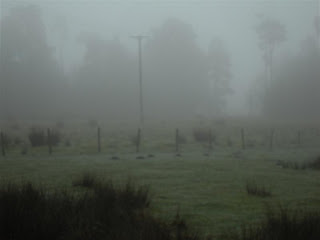.JPG)
TOO MISTY TO FIND MUCH AT OLD LODGE NATURE RESERVE (Graham)
Our next stop was Newhaven where we hoped to see the Purple Sandpipers that roost on the eastern arm of the harbour. Fortunately, there was no mist, in fact the air was crystal clear. High tide wasn't until 3.30 p.m. so we had a few hours to kill.
+(Medium).JPG)
THE EASTERN ARM OF NEWHAVEN HARBOUR (Graham)
Walking along to the cliffs to the west of the harbour we noted 15 Curlews, 6 Oystercatchers and a Sparrowhawk but it was very quiet, with the sea very calm and little on the move.
+(Medium).JPG)
THE ROCKY AREA UNDER THE CLIFFS (Graham)
Back at the harbour, a couple of Rooks were perched up on a fence and we were surprised to hear a Raven cronking away over the fort. We soon picked it out, being mobbed by Carrion Crows and Jackdaws and then spotted a second bird that had appeared from nowhere.
One bird flew off whilst the other perched on the cliff, calling continuously.
.JPG)
ROOK at Newhaven, East Sussex (Graham)
+(Medium).jpg)
RAVEN at Newhaven, East Sussex (Graham)
We spent the next hour or so looking at the numerous Herring Gulls and eventually the incoming tide reached the stage where we felt there was a good chance that the Purple Sandpipers might put in an appearance.
+(Medium).JPG)
Adult HERRING GULL at Newhaven, East Sussex (Graham)
+(Medium).JPG)
2nd-winter HERRING GULL at Newhaven, East Sussex (Graham)
+(Medium).JPG)
1st-winter HERRING GULL at Newhaven, East Sussex (Graham)
(details of the rings sent to the BTO, it will be interesting to find out where it was ringed)
It wasn't too long before we picked out three birds on the concrete supports, just above the water line on the eastern arm of the harbour. Very distant views though so, after a discussion with one of the local birders on how to get to that side of the mouth of the river, we headed off to get a closer look.
.jpg)
PURPLE SANDPIPERS, BUT WE WANTED CLOSER VIEWS (Graham)
We parked at an industrial estate and made the longish walk to the east arm, across some very good scrubby habitat that looked promising for holding migrants at the right time of year. Just before reaching the eastern harbour arm, we noticed a male Stonechat perched on a chainlink fence and then a couple of Black Redstarts joined it briefly.
On to the harbour arm and a look over the edge at the concrete supports soon revealed close views of the Purple Sandpipers. Stunning little waders when seen at close quarters. I managed just one shot of one bird, but there were at least three birds present.
+(Medium).jpg)
PURPLE SANDPIPER at Newhaven, East Sussex (Graham)
Satisfied that we had added a couple more birds to our year's tally we headed back to Old Lodge Nature Reserve and spent half an hour in the dark listening to a Tawny Owl hooting before heading home.
Paul & Graham
Setting off from Surrey in the dark, we arrived at Shellness on Sheppey at about 7.15 a.m. but the tide was still very low. We did see plenty of Oystercatchers and Redshanks out on the mussel beds, but apart from several Meadow Pipits, one Rock Pipit and a female Hen Harrier, little else was showing, so we decided to move on to Capel Fleet for an hour or so.
Standing on the raptor watchpoint, we were rewarded with good views of at least 6 Marsh Harriers, 2 female Hen Harriers, a distant Peregrine that was being mobbed by a Marsh Harrier and eventually landed on a field (and remained there for 30 minutes or more), a Sparrowhawk and a Kestrel.
+(Medium).JPG)
Male Marsh Harrier, Capel Fleet (Graham)
+(Medium).JPG)
Male Marsh Harrier, Capel Fleet (Graham)
+(Medium).JPG)
Spot the Peregrine, Capel Fleet (Graham)
Also at Capel Fleet, 9 Bearded Tits flew up high out of the reeds near the viewpoint and headed along the fleet. Three Ruff and around 200 Golden Plover were in flight and several Red-legged Partridges were sent into a panic by one of the Hen Harriers. Unfortunately we failed to see any Merlins or Short-eared Owls, which were our target birds for the day.
We decided to head on to the Elmley RSPB reserve, which turned out to be a bad decision.
There was little of interest, either along the access track or on the reserve. As we walked to the first hide, 55 Barnacle Geese flew over our heads and at the hide they could be seen distantly in the company of what looked like two Emperor Geese. The Barnacles were almost certainly feral birds. Apart from one or two Marsh Harriers, little else was about and it is the first time that I have ever failed to see waders at Elmley.
+(Medium).JPG)
Feral Barnacle Geese, RSPB Elmley (Graham)
Slightly disappointed, we trudged the mile and a quarter back to the car and headed back to Shellness. By now, the tide was in and there were plenty of Turnstones along what remained exposed of the shell-strewn beach.
Eight Little Egrets were on the saltmarsh and a female Hen Harrier did a distant fly-past. About 20 Curlews were roosting on the saltmarsh as we walked towards the blockhouse.
+(Medium).JPG)
Turnstone, Shellness (Graham)
+(Medium).JPG)
Turnstones and Dunlin, Shellness (Graham) 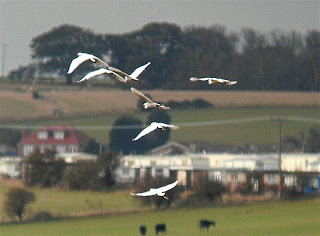+(Medium).JPG)
Little Egrets, Shellness (Graham)
+(Medium).JPG)
Female Hen Harrier, Shellness (Graham) Beyond this point we were treated to the sight of thousands of waders roosting on the beach, mainly Dunlin but also large numbers of Grey Plover and Knot with a few Ringed Plovers thrown in for good measure.
+(Medium).JPG)
The wader roost at Shellness (Graham) On the more distant spit, several hundred Oystercatchers and around 60 Bar-tailed Godwits were roosting. A few Brent Geese were on the Swale and came quite close to the shore but, with the westerly wind, sea-watching a waste of time.
+(Medium).JPG)
Oystercatchers and Bar-tailed Godwits (Graham) The time was getting on, so we decided to move back to the raptor watchpoint at Capel Fleet to see if we could locate a Merlin or Short-eared Owl.
No luck, but a couple of Green Sandpipers flew over and, as the light quickly faded, we headed back along the Harty Ferry Road and picked out a Barn Owl perched on a fence post by the road (too dark for a photo).
By now, it was time to call it a day and we headed back home.
Paul & Graham
.JPG)
.JPG)
.JPG)
+(1)+(Medium).JPG)
+(1)+(Medium).JPG)
+(1)+(Medium).JPG)
.JPG)
+(Medium).JPG)
.JPG)
.JPG)
.JPG)
.JPG)
.JPG)
+(Medium).JPG)
+(1)+(Medium).JPG)
.JPG)
.JPG)
.JPG)
+(Medium).JPG)
+(Medium).JPG)
.JPG)
+(Medium).jpg)
+(Medium).JPG)
+(Medium).JPG)
+(Medium).JPG)
.jpg)
+(Medium).jpg)
+(Medium).JPG)
+(Medium).JPG)
+(Medium).JPG)
+(Medium).JPG)
+(Medium).JPG)
+(Medium).JPG)
.jpeg)
+(Medium).JPG)
+(Medium).JPG)
+(Medium).JPG)
+(Medium).JPG)
+(Medium).JPG)
+(Medium).JPG)
+(Medium).JPG)
+(Medium).JPG)
+(Medium).JPG)
+(Medium).JPG)